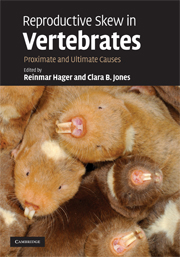Foreword
Published online by Cambridge University Press: 02 February 2010
Summary
A brief history of skew theory
New ideas in science don't spring out of nowhere; they combine and build from earlier ones. The concept of reproductive skew is no different, and it is nice to have this opportunity to look back, over 30 years ago now, and identify the various sources and give credit where it's due. The story begins in 1974 at the 16th International Ornithological Congress in Canberra, Australia. During that long flight to Australia from Johannesburg, South Africa, the pilot came on the loudspeaker and announced that the United States President Richard Nixon had just resigned in disgrace over the Watergate scandal. Having been in the field in Africa all summer, this was a shocking return to civilization. Ian Rowley had convened the first symposium on cooperative breeding in birds, with himself, Lew Grimes, Glen Woolfenden, and Amotz Zahavi presenting surveys of the cooperatively breeding species in their respective continents (Australia, Africa, the Americas, and Europe) (Grimes 1976, Rowley 1976, Woolfenden 1976, Zahavi 1976). All four speakers noted that the helper-at-the-nest formof cooperative breeding, where offspring remain on the parental territory, delay breeding, and assist with the care of subsequent broods of their parents, was by far the most common one. Cooperative breeding was associated with a variety of habitats and climates, but most were characterized by sedentary residence on territories or fixed home ranges. Habitat saturation was identified by Woolfenden and Zahavi as the primary force favoring prolonged retention of offspring on the parental territory.
- Type
- Chapter
- Information
- Reproductive Skew in VertebratesProximate and Ultimate Causes, pp. xi - xviiiPublisher: Cambridge University PressPrint publication year: 2009

